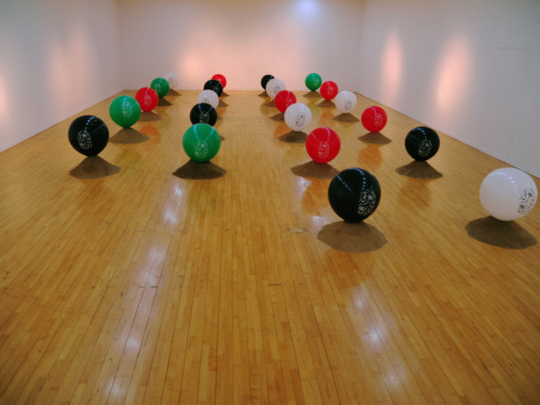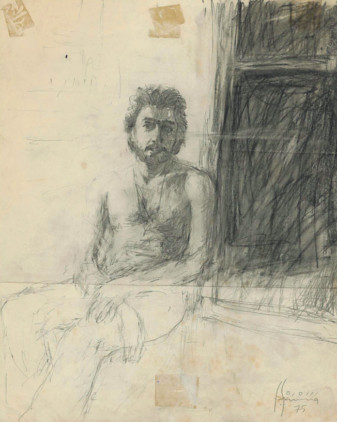
Ayyam Gallery is hosting the first suggestive retrospective of well-known Saudi artist Faisal Samra’s work. The multimedia artist, who is a pioneer of conceptual art in the region, is interested in sociopolitical as well as existential themes.
The retrospective of his work, titled “39” celebrates the depth and breadth of his practice through key works created over the last 39 years. The artworks range from drawings done when Samra was a student at the École Nationale Supérieure des Beaux-Arts in Paris to recent politically charged works, many of which have never been shown in public before.
The show highlights Samra’s ongoing investigation of the figure through existential themes, and his ability to create works that capture the zeitgeist, while also being timeless.
The earliest works in the show include pencil studies of model movements done at art school in the mid-1970s, the only self portrait he has ever done and drawings of things that caught his eye such as a butcher’s shop in Egypt, a football game in the US and the wing of a plane.
Later works, such as “The Other Body” series from 1997 reflect his exploration of industrial materials such as wire mesh to create organic forms over which his canvases are stretched like a skin. “I dyed the canvases with natural pigments, subjected them to various forms of erosion and burnt them to indicate the ravages of time and the environment on living beings; but these artworks also demonstrate that something new emerges from the destruction,” Samra says.
In subsequent series, the wire mesh is vaguely shaped like a head or a body, with various objects and melted plastic pieces trapped inside. “The mixed media elements imprisoned inside the wire mesh and veiled by it are like the things in our lives that we can see but cannot touch or grasp such as the idea of death,” the artist says.
In his “Moalaqats” series, also from the 1990s Samra freed his canvas from the frame, presenting it as a suspended, organic installation.
“This work is inspired by the ancient tradition of displaying the best poems by leading Arab poets in public places. Known as ‘Moalaqat’, these are the oldest known hanging artworks in Islamic history. Rather than creating a square, stretched canvas, which is like an opening in the wall through which you look, I wanted my paintings to include the space around them. Hence I cut the canvases and suspended them so that they could have a dialogue with the surroundings,” he says.
A set of drawings, titled “Dancer” from his 2002 “Domesticated Energy” series highlights the artist’s abiding interest in movement, metaphysical themes, surpassing the boundaries of figuration, and our perception of reality.
“Here I have used charcoal powder to create a gestural, abstracted suggestion of a mass of energy composed of sensations, feelings and desires confined within lines that represent the body and spirit. My research here was concentrated on one mass of energy, at a particular time and in a closed space. It was about looking at how our mind controls the positive and negative energy residing in us,” he says.
While this series is about the internal world, Samra’s most acclaimed work, the “Distorted Reality” series (2005-2011) speaks about the altered realities in the external world. The series features performative videos and digital photographs articulating a rebellion against the mass media dominated visual culture of our times.
Here, the artist’s identity is veiled behind rolls of canvas, elaborate costumes or head coverings, while the camera captures the sequence of his movements and actions as he plays with the layers of fabric engulfing him.
With references to words and images from advertisements in the background, the work looks at the way we are engulfed by the altered or distorted reality created by advertisements and their unseen creators. The show features the first video in this series along with several later works, offering insights into the development of this body of work and the social and metaphysical themes it addresses.
In a video installation from 2012 titled “Shanty”, the artist deals with the issue of poverty and the invisible walls that divide different strata of society. And in the “C.D.R.” series of mixed media installations, he documents the eternal cycle of Construction, Destruction and Reconstruction in nature and in our lives. The series includes a work suggesting that the Western world needs to reconstruct the way it looks at the East.
The conflict between East and West is also referenced in “Arab Spring”, an installation featuring 22 balloons emblazoned with the words “Arab Spring” floating over sand graves.
“The term Arab Spring was invented by the Western media. The fragile balloon of the Arab Spring has been inflated by western media and politicians with vested interests to the point of explosion. The 22 balloons in this installation represent the Arab countries with the colours of all their flags. This work goes back to the history of the West’s domination and manipulation of the East, and questions the West’s role in the current turmoil in the region. And the graves are a homage to the children who have died in the ‘Arab Spring’ and are still dying,” the artist says.
“My work is existential but rooted in the here and now. It is about how we relate to everything around us. I am not conveying messages or finding solutions; I just want to create awareness about different issues that affect our body, mind and soul. I look for the truth in the distorted reality surrounding us, and describe it as I see it, because I believe that this is the role of art,” he adds.
Jyoti Kalsi is an arts enthusiast based in Dubai.
“39” will run at Ayyam Gallery, Al Quoz until January 10, 2015














